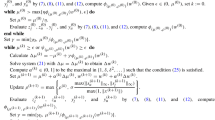Abstract
This paper addresses the issues involved with an interior point-based decomposition applied to the solution of linear programs with a block-angular structure. Unlike classical decomposition schemes that use the simplex method to solve subproblems, the approach presented in this paper employs a primal-dual infeasible interior point method. The above-mentioned algorithm offers a perfect measure of the distance to optimality, which is exploited to terminate the algorithm earlier (with a rather loose optimality tolerance) and to generate ∈-subgradients. In the decomposition scheme, subproblems are sequentially solved for varying objective functions. It is essential to be able to exploit the optimal solution of the previous problem when solving a subsequent one (with a modified objective). A warm start routine is described that deals with this problem. The proposed approach has been implemented within the context of two optimization codes freely available for research use: the Analytic Center Cutting Plane Method (ACCPM)—interior point based decomposition algorithm and the Higher Order Primal-Dual Method (HOPDM)—general purpose interior point LP solver. Computational results are given to illustrate the potential advantages of the approach applied to the solution of very large structured linear programs.
Similar content being viewed by others
References
A. Altman and K.C. Kiwiel, “A note on some cutting plane methods for convex feasibility and minimization problems,” Computational Optimization and Applications, vol. 5, pp. 175–180, 1996.
E. Andersen, J. Gondzio, C. Meszaros, and X. Xu, “Implementation of interior point methods for large scale linear programming,” in Interior Point Methods in Mathematical Programming, T. Terlaky (Ed.), Kluwer Academic Publishers: Dordrecht 1996, pp. 189–252.
O. Bahn, A. Haurie, S. Kypreos, and J.-P. Vial, “A multinational MARKAL model to study joint implementation of carbon dioxide emission reduction measures,” in Joint Implementation of Climate Change Commitments, P. Ghosh and J. Puri (Eds.), Tata Energy Research Institute, 1994.
J.F. Benders, “Partitioning procedures for solving mixed-variables programming problems,” Numerische Mathematik, vol. 4, pp. 238–252, 1962.
Cplex Optimization Inc., Incline Village, NV 89451–9436. Using the Cplex Callable Library, 1995.
G.B. Dantzig and P. Wolfe, “The decomposition algorithm for linear programming,” Econometrica, vol. 29, pp. 767–778, 1961.
J. Day and A. Haurie, Private communication, Logilab, University of Geneva, 1997.
O. du Merle, J.-L. Goffin, and J.-P. Vial, “On the comparative behavior of Kelley's cutting plane method and the analytic center cutting plane method,” Technical Report, Logilab, University of Geneva, 102 Bd Carl-Vogt, CH-1211, March 1996. Computational Optimization and Applications (in press).
D.M. Gay, “Electronic mail distribution of linear programming test problems,” Mathematical Programming Society COAL Newsletter, vol. 13, pp. 10–12, 1985.
J.-L. Goffin, A. Haurie, and J.-P. Vial, “Decomposition and nondifferentiable optimization with the projective algorithm,” Management Science, vol. 38, pp. 284–302, 1992.
J.-L. Goffin, A. Haurie, J.-P. Vial, and D.L. Zhu, “Using central prices in the decomposition of linear programs,” European Journal of Operational Research, vol. 64, pp. 393–409, 1993.
J.-L. Goffin, Z.Q. Luo, and Y. Ye, “On the complexity of a column generation algorithm for convex and quasiconvex feasibility problems,” in Large Scale Optimization: State of the Art, W.W. Hager, D.W. Hearn, and P.M. Pardalos (Eds.), Kluwer Academic Publishers: Dordrecht, 1993, pp. 187–196.
J.-L. Goffin, Z.Q. Luo, and Y. Ye, “Complexity analysis of an interior point cutting plane method for convex feasibility problems,” SIAM Journal on Optimization, vol. 6, pp. 638–652, 1996.
J.-L. Goffin and J.-P. Vial, “Shallow, deep and very deep cuts in the analytic center cutting plane method,” Technical Report, Logilab, University of Geneva, 102 Bd Carl-Vogt, CH-1211, May 1996. Mathematical Programming (in press).
J. Gondzio, “HOPDM (version 2.12)—a fast LP solver based on a primal-dual interior point method,” European Journal of Operational Research, vol. 85, pp. 221–225, 1995.
J. Gondzio, “Multiple centrality corrections in a primal-dual method for linear programming,” Computational Optimization and Applications, vol. 6, pp. 137–156, 1996.
J. Gondzio, “Warm start of the primal-dual method applied in the cutting plane scheme,” Mathematical Programming, vol. 83, pp. 125–143, 1998.
J. Gondzio, O. du Merle, R. Sarkissian, and J.-P. Vial, “ACCPM—a library for convex optimization based on an analytic center cutting plane method,” European Journal of Operational Research, vol. 94, pp. 206–211, 1996.
J. Gondzio and R. Sarkissian, “Column generation with the primal-dual method,” Technical Report, Logilab, University of Geneva, 102 Bd Carl-Vogt, CH-1211, June 1996.
J. Gondzio and T. Terlaky, “A computational view of interior point methods for large scale linear programming,” in Advances in Linear and Integer Programming, J. Beasley (Ed.), Oxford University Press: Oxford, 1996, pp. 103–144.
J.E. Kelley, “The cutting plane method for solving convex programs,” Journal of the SIAM, vol. 8, pp. 703–712, 1960.
K.C. Kiwiel, “Efficiency of the analytic center cutting plane method for convex minimization,” SIAM Journal on Optimization, vol. 7, pp. 336–346, 1997.
I.J. Lustig, R.E. Marsten, and D.F. Shanno, “Interior point methods for linear programming: computational state of the art,” ORSA Journal on Computing, vol. 6, pp. 1–14, 1994.
N. Nakicenovic, A. Gruebler, A. Inaba, S. Messner, S. Nilsson, Y. Nishimura, H-H. Rogner, A. Schaefer, L. Schrattenholzer, M. Strubegger, J. Swisher, D. Victor, and D. Wilson, “Long-term strategies for mitigating global warming,” Energy—The International Journal, vol. 18,no. 5, pp. 409–601, 1993.
Y. Nesterov, “Complexity estimates of some cutting plane methods based on the analytic center,” Mathematical Programming, vol. 69, pp. 149–176, 1995.
J. Renegar, “A polynomial-time algorithm, based on Newton's method, for linear programming,” Mathematical Programming, vol. 40, pp. 59–93, 1988.
J.-P. Vial, “A generic path-following algorithm with a sliding constraint and its application to linear programming and the computation of analytic centers,” Technical Report, Logilab, University of Geneva, 102 Bd Carl-Vogt, CH-1211, February 1996.
S. Wright, Primal-Dual Interior Point Methods, SIAM: Philadelphia, 1997.
Author information
Authors and Affiliations
Rights and permissions
About this article
Cite this article
Gondizo, J., Vial, JP. Warm Start and ε-Subgradients in a Cutting Plane Scheme for Block-Angular Linear Programs. Computational Optimization and Applications 14, 17–36 (1999). https://doi.org/10.1023/A:1008748810765
Issue Date:
DOI: https://doi.org/10.1023/A:1008748810765




